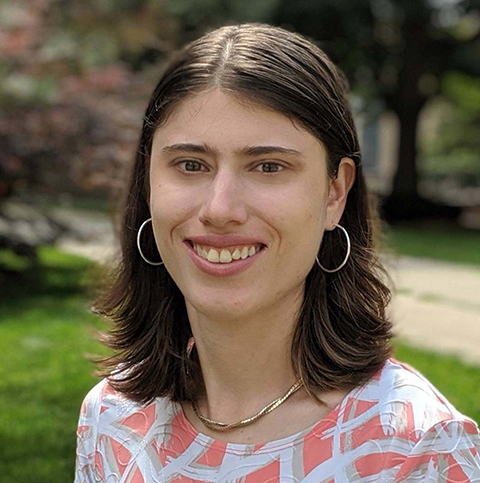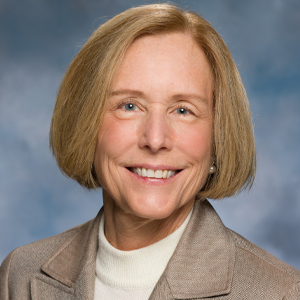Talking about science outreach and communication
To increase awareness of American Society for Biochemistry and Molecular Biology activities, I’ve been talking to chairs of the committees that steer the society’s initiatives.
I recently spoke with Christina Swords of the Science Outreach and Communication Committee. A graduate medical education coordinator at the University of Wisconsin–Madison, she has chaired the committee since 2022.

This conversation has been edited.
When did you become an ASBMB member — and what attracted you to the society?
I was finishing my Ph.D. work in 2018 at the University of North Carolina at Chapel Hill. Throughout grad school, I had been involved in a lot of science outreach efforts, and I wanted to integrate outreach into my future career.
I read about SciOut18 (an initiative of the ASBMB Science Outreach and Communication Committee), applied, was accepted and attended the two-day conference in New York City. There I networked with committee members who encouraged me to keep in touch, and I did. A trainee position on the committee opened while I was a postdoc at the University of Wisconsin–Madison, and I’ve been a member since then.
What motivates you to participate in society activities?
In my current role, I support postdoctoral fellows. ASBMB membership allows me to stay connected with scientists and the research community even though I’m no longer at the bench every day. I keep up with the scientist part of my personality through activities such as reading ASBMB Today articles or going to science sessions at the annual meeting. It’s important for my continued development as a scientist, and it makes me a better science communicator because it keeps me up to date on new research and helps maintain my credibility.
What activities of the committee are you most excited about?
At DiscoverBMB, we welcomed about 30 high school students and their mentors from the Seattle area into the conference space for a new initiative called Community Day. We designed programming specifically for them, including science talks by ASBMB members, hands-on demos by committee members, innovation discovery at exhibitor booths and conversations with scientists, all geared toward introducing them to what happens at a scientific conference and paving the way for their future in science.
Also, the Art of Science Communication course, which the committee has been passionate about since its launch in 2015, was updated this year.
For members unfamiliar with this course, what does it provide?
The course provides the foundational knowledge for any scientist to communicate their work to a nonexpert audience. It’s open to scientists at any career level living anywhere in the world.
It’s a flipped classroom model. Participants watch online content asynchronously and do small assignments. Then they come together in small groups with a facilitator to discuss the content and workshop their science communication pieces. This format provides an opportunity to network with other scientists who are interested in science communication and an opportunity to practice. For most folks, science communication does not come naturally. It’s a skill that we develop, and just like running a PCR gel, it gets better with practice.
What’s new in the updated course?
How the material is presented is new, although a lot of the fundamental content is the same. We know from best practices that information is retained better when it’s gleaned from a dialogue or a conversation.
We also involved more members of the committee in the videos. The modules present a greater diversity that better reflects the nature of science and scientists.
There is one new module on storytelling. The structure of a story can engage an audience because it’s ingrained in us as humans. Stories help start dialogues and conversations, which is really the goal of many science communication initiatives.
The course is offered twice a year. Summer enrollment begins in June, and the session runs through July and August. Winter enrollment begins in January, and the session runs through February and March.
How can ASBMB members get involved with your committee?
We encourage participation in almost all initiatives. We want members to meet students at Community Day. Just let us know, and we’ll keep names on a list for next year’s meeting in San Antonio.
We’ve started a member spotlight initiative. Through short interviews shared on the website and social media, we aim to highlight and celebrate ASBMB members engaged in outreach. We know they’re out there, and we know they’re passionate about what they do. We want to help demonstrate their work.
We offer grants for outreach projects that might need a little help with funding. The application window is late summer through October, and we encourage everyone to apply.
Finally, the Art of Science Communication course would not exist without facilitators. These are folks who have completed the course successfully and then return to lead the weekly discussion sessions. We ask for volunteers twice a year. It’s a great way to keep up science communication skills.
What do you find rewarding about being an Art of Science Communication facilitator?
For me, it’s being part of a team that offers science communication training so broadly. We hear from many participants that if it weren’t for this online course, they would not have had the opportunity to develop skills that are important to them professionally, educationally or personally. The ASBMB is filling an important gap in the scientist training space.
The course addresses current societal challenges — mistrust of science and misinformation. We hope we’re developing scientists who are sensitive to this and can be part of the solution. I’m proud to help facilitate that conversation.
Enjoy reading ASBMB Today?
Become a member to receive the print edition four times a year and the digital edition monthly.
Learn moreGet the latest from ASBMB Today
Enter your email address, and we’ll send you a weekly email with recent articles, interviews and more.
Latest in Opinions
Opinions highlights or most popular articles

The tortoise wins: How slowing down saved my Ph.D.
Graduate student Amy Bounds reflects on how slowing down in the lab not only improved her relationship with work but also made her a more productive scientist.

How pediatric cataracts shaped my scientific journey
Undergraduate student Grace Jones shares how she transformed her childhood cataract diagnosis into a scientific purpose. She explores how biochemistry can bring a clearer vision to others, and how personal history can shape discovery.

Debugging my code and teaching with ChatGPT
AI tools like ChatGPT have changed the way an assistant professor teaches and does research. But, he asserts that real growth still comes from struggle, and educators must help students use AI wisely — as scaffolds, not shortcuts.

AI in the lab: The power of smarter questions
An assistant professor discusses AI's evolution from a buzzword to a trusted research partner. It helps streamline reviews, troubleshoot code, save time and spark ideas, but its success relies on combining AI with expertise and critical thinking.

How AlphaFold transformed my classroom into a research lab
A high school science teacher reflects on how AI-integrated technologies help her students ponder realistic research questions with hands-on learning.

Writing with AI turns chaos into clarity
Associate professor shares how generative AI, used as a creative whiteboard, helps scientists refine ideas, structure complexity and sharpen clarity — transforming the messy process of discovery into compelling science writing.

